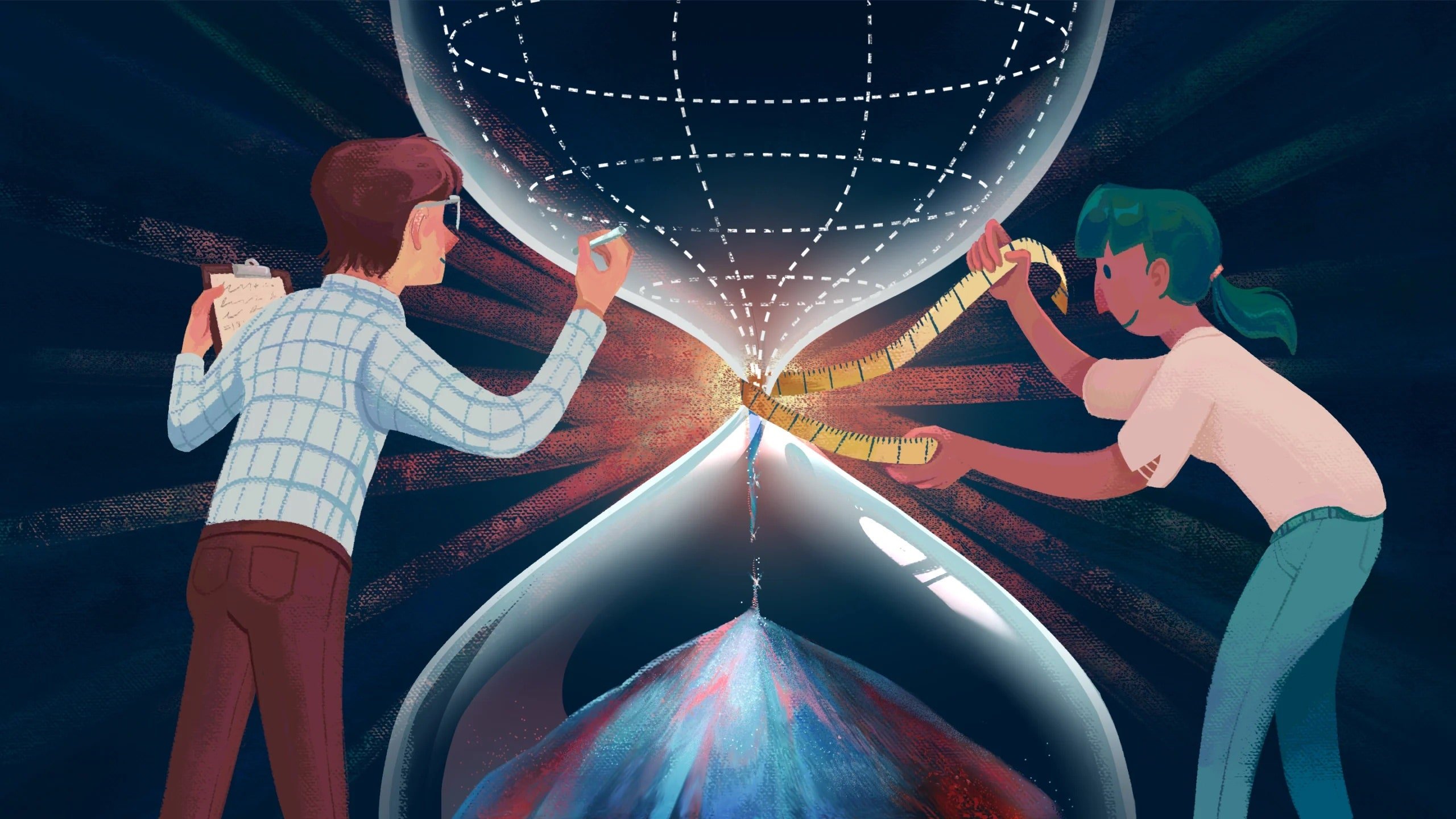
In Short
- Big Bang Theory: Describes the universe’s origin as a hot, compact ball of energy that exploded 13.8 billion years ago.
- Inflation: A brief phase of rapid expansion following the Big Bang.
- Pre-Inflationary State: Researchers extend Einstein’s theory to explore what might have preceded inflation.
- Singularity: A point where mathematical explanations break down; researchers debate whether it can be “seen beyond.”
- New Findings: Geshnizjani, Ling, and Quintin’s work challenges our understanding of the singularity and the universe’s origins.
TFD – Researchers have uncovered new insights into the Big Bang singularity, shedding light on the early universe’s inflation and the potential pre-inflationary state. Dive into the groundbreaking findings from Geshnizjani, Ling, and Quintin as they explore the cosmos’ origins and challenge our understanding of the universe.
The original version of this story appeared in Quanta Magazine.
The universe was made up of a tiny, compact, hot ball of energy that abruptly burst 13.8 billion years ago.
According to the widely accepted scientific hypothesis of the Big Bang, which originated in the 1920s, it is how everything started. Over the years, the tale has been refined; most notably in the 1980s, when many cosmologists came to believe that the universe began with a brief phase of exceptionally fast expansion known as inflation, which was followed by a lower speed.
It is believed that a unique type of high-energy matter caused that brief period of time by flipping the laws of gravity, “inflating” the universe’s fabric exponentially fast and expanding it by a factor of a million billion billion in less than a billionth of a billionth of a billionth of a second. When astronomers study the cosmos at enormous scales, inflation explains why it looks so uniform and smooth.
However, if inflation is to blame for everything that is visible today, then what, if anything, came before?
There is currently no experiment designed to observe the pre-inflationary state. Mathematicians may, however, illustrate a few potential situations. The plan is to extend Einstein’s general theory of relativity as far back in time as possible, which links gravity to the curvature of space-time.
Three researchers—Eric Ling from the University of Copenhagen, Jerome Quintin from the University of Waterloo, and Ghazal Geshnizjani from the Perimeter Institute—hope that. “We mathematically showed that there might be a way to see beyond our universe,” Ling stated in a recent paper the three of them published in the Journal of High Energy Physics.

Robert Brandenberger, a physicist at McGill University who was not involved with the study, said the new paper “sets a new standard of rigor for the analysis” of the mathematics of the beginning of time. Sometimes what looks like a singularity—a place in space-time where mathematical explanations become meaningless—turns out not to be a singularity after all.
The main question facing Geshnizjani, Ling, and Quintin is whether the rules of gravity break down in a singularity before or before inflation. What happens to the function 1/x as x gets closer to zero is the most basic illustration of a mathematical singularity. The function produces a different number after accepting a number x as input. As x gets smaller and smaller, 1/x gets larger and larger, approaching infinity. If x is zero, the function is no longer well defined: It can’t be relied upon as a description of reality.

Mathematicians can, nevertheless, occasionally avoid a singularity. Take the prime meridian, for instance, which crosses Greenwich, England, at longitude zero. In Greenwich, a function with a value of 1/longitude would go crazy. Suburban London isn’t particularly unique physically, though; you could just as easily redefine zero longitude to travel through another location on Earth, and your function would then operate as usual as it got closer to Greenwich’s Royal Observatory.
At the boundary of mathematical models of black holes, a similar phenomenon occurs. The physicist Karl Schwarzschild’s 1916 equations for spherical nonrotating black holes contain a term whose denominator approaches zero at the black hole’s event horizon, which is the boundary beyond which nothing can escape. As a result, scientists came to think of the event horizon as a physical singularity. But eight years later the astronomer Arthur Eddington showed that if a different set of coordinates is used, the singularity disappears. Like the prime meridian, the event horizon is an illusion: a mathematical artifact called a coordinate singularity, which only arises because of the choice of coordinates.
Using a new coordinate system cannot erase the density and curvature that reach infinity at the center of a black hole. General relativity’s laws begin to make no sense. One term for this is a curvature singularity. It suggests that there is something going on that present mathematics and physical theories are unable to explain.
Geshnizjani, Ling, and Quintin investigated the question of whether the Big Bang’s beginning is more like to an event horizon or the center of a black hole. Their research expands upon a theorem established in 2003 by Alexander Vilenkin, Arvind Borde, and Alan Guth—one of the pioneers of the concept of inflation. According to this theorem, which goes by the authors’ initials BGV, inflation could not have started endlessly in the past. Instead, it had to have a beginning. Something had to have been single to begin with. BGV establishes the existence of this singularity, without saying what kind of singularity it is.
According to Quintin, he and his associates have endeavored to determine if the singularity is a curtain that can be drawn back, or a curved singularity, like a brick wall. It improves our understanding of the Big Bang singularity, according to Eric Woolgar, a mathematician from the University of Alberta who was not involved in the work. “They can determine whether the singularity is more mild or infinite at the beginning, which might enable us to expand our model of the universe to pre-Big Bang eras.”

The three researchers utilized a scale factor—a measure of how the distance between things has changed over time as the cosmos expands—to categorize potential pre-inflationary situations. The Big Bang is the point in time when everything was compressed into a dimensionless point and the scale factor was zero.
The scale factor expanded exponentially during the inflationary period. The scale factor may have been different in a lot of ways prior to inflation. A taxonomy of singularities for various scale-factor scenarios is presented in the new paper. According to Ling, “we demonstrate that the scale factor will produce a curvature singularity under certain conditions and does not under other conditions.”
Scientists already recognized that the BGV theorem’s identification of the beginning of inflation is a cancellous singularity that can be removed in a world with so-called dark energy but no matter. Of certainly, matter exists in the real universe. Could its singularity also be circumvented by mathematical tricks? The researchers demonstrated that the singularity can be eliminated if the amount of matter is insignificant in comparison to the amount of dark energy. “Light rays can actually go through the boundary,” Quintin said. “And in that sense, you can see beyond the boundary; it’s not like a brick wall.” The universe’s history would extend beyond the Big Bang.
Cosmologists believe that matter outweighed energy in the early cosmos. In this instance, the new research demonstrates that the BGV singularity—the point at which the rules of gravity break—would actually be a physical curvature singularity.
A singularity suggests that the fundamental laws of physics cannot be fully described by general relativity. There are ongoing attempts to formulate such a description, which would necessitate bringing general relativity and quantum physics into harmony. According to Ling, he regards the recent research as a first step toward this hypothesis. In order to make sense of the universe at the highest energy levels, he said, “we first need to understand classical physics as well as we can.”
This article was originally published in Quanta Magazine, an editorially independent journal of the Simons Foundation. Its goal is to improve public understanding of science by reporting on trends and developments in mathematics, the physical and biological sciences, and research advances in these fields. Reprinted with permission.
Conclusion
The exploration of the Big Bang singularity by Geshnizjani, Ling, and Quintin offers new perspectives on the early universe and its inflationary period. Their work highlights the complexities and mysteries of cosmology, encouraging further research to unravel the universe’s origins. As we push the boundaries of our understanding, these findings remind us of the intricate dance between mathematics and physics that shapes our comprehension of the cosmos. Stay informed with Quanta Magazine for more scientific breakthroughs and insights.
Connect with us for the Latest, Current, and Breaking News news updates and videos from thefoxdaily.com. The most recent news in the United States, around the world , in business, opinion, technology, politics, and sports, follow Thefoxdaily on X, Facebook, and Instagram .
